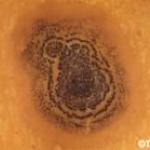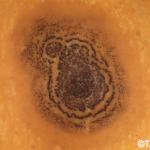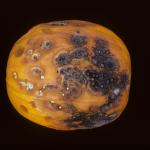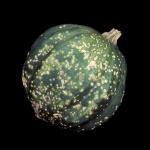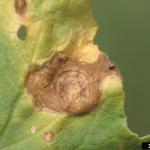Cucurbits, Black Rot
Didymella bryoniae
Black rot is the fruit rot phase of the gummy stem blight pathogen, Didymella bryoniae (Phoma cucurbitacaerum). It is characterized by a distinctive black decay of the fruits of all cucurbits. In temperate regions, the disease occurs mainly on winter squash, pumpkin, and greenhouse cucumber. The disease is most often noticed at harvest, but can be seen during crop and fruit growth when scouting inside the canopy.
Identification:
Symptoms vary on different cucurbits. On pumpkin and winter squash, symptoms on the leaves begin as a marginal necrosis followed by larger, wedged shaped necrotic areas, often with a yellow halo. Stem cankers develop in the cortical tissue and a brown, gummy exudate is produced. Small fruiting bodies (pycnidia or perithecia), may appear as black specks in diseased tissue. Stems may be girdled on seedlings and the plant dies, or on older plants stem cankers lead to wilt and decline. Small, water-soaked spots develop on fruit, enlarge, and exude gummy material and contain many black, fruiting bodies. Black rot on butternut may appear as a superficial hardened tan to white area which can develop concentric rings. This typically occurs where the fruit touched the soil. Lesions may become hardened and dormant on mature fruit that is cured and stored under proper conditions, but chilling injury or high humidity may activate the disease and cause fruit collapse during storage. Check fruit weekly for signs of black rot.
Life Cycle:
D. bryoniae is both seed and soil borne. The pathogen may be carried in or on seed. In the field, the fungus can survive in infected plant residue for more than one year. The disease is favored by relative humidity over 85% and leaf wetness periods greater than one hour. The optimum temperature for disease development is 75-77°F. Leaves are penetrated directly by the fungus, stems are infected through wounds or expansion of leaf lesions, and fruit are infected through flower scars or wounds. Wounding, striped cucumber beetle injury, aphid feeding, and powdery mildew all predispose plants to black rot infection. Control of powdery mildew by chemicals or by planting PM-resistant varieties can significantly reduce black rot in pumpkins and winter squash. On fruit held for fall sales or winter storage, a water-soaked lesion develops, usually associated with an injury to the rind, and soon black rot develops. Large Halloween pumpkins are more susceptible to black rot than smaller pie types.
Cultural Controls & Prevention:
- Use certified disease-free seed for all cucurbit plantings.
- Rotate out of cucurbits for two years.
- Crop debris should be plowed under promptly after harvest.
- Control of black fruit rot starts with control of gummy stem blight.
- Powdery mildew tolerant cultivars should be selected and powdery mildew should be controlled, as this disease predisposes the crop to black rot.
- Control cucumber beetles and aphids.
- Handle winter squash and pumpkin carefully during harvest to minimize wounding.
- Cure pumpkin and squash at 85°F for two weeks before storage. An empty greenhouse may work well for this.
- Avoid chilling injury to winter squash and pumpkins as this activates dormant black rot lesions and increases losses in storage.
- Satisfactory control can be obtained by regular application of protectant fungicides.
Chemical Controls & Pesticides:
For current information on disease recommendations ins specific crops including information on chemical control & pesticide management, please visit the New England Vegetable Management Guide website.
Crops that are affected by this disease:
The Center for Agriculture, Food and the Environment and UMass Extension are equal opportunity providers and employers, United States Department of Agriculture cooperating. Contact your local Extension office for information on disability accommodations. Contact the State Center Director’s Office if you have concerns related to discrimination, 413-545-4800 or see ag.umass.edu/civil-rights-information.
